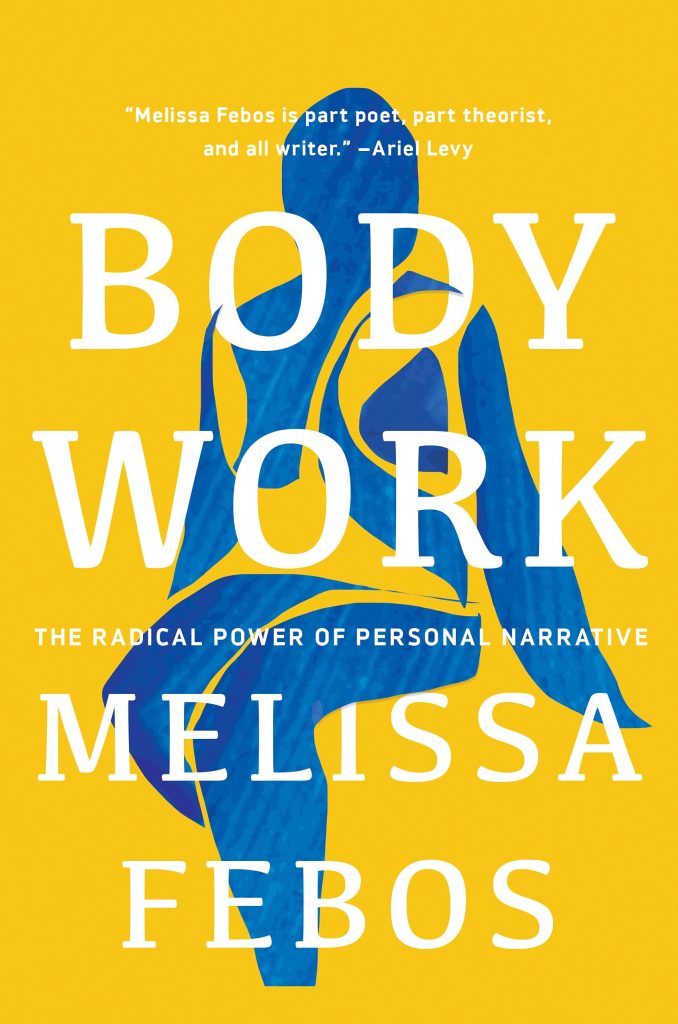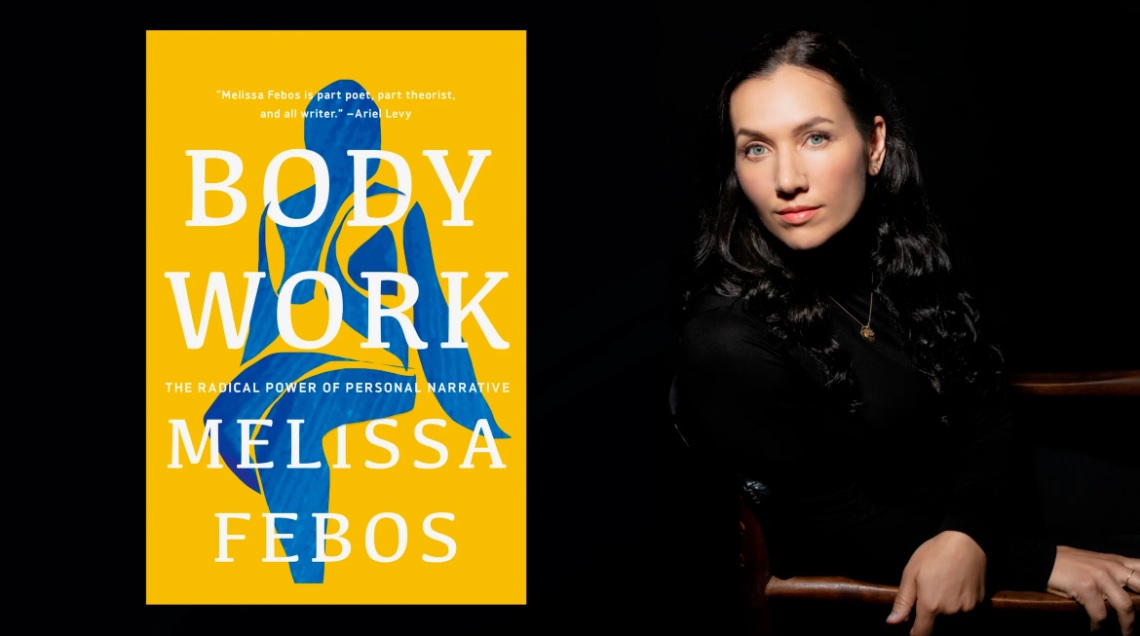Photograph of Melissa Febos by Beowulf Sheehan
I am beginning the new year by writing about the best craft book I read in 2022 because I want us—me and you too, dear reader—to carry this book with us not only into 2023, but into the rest of our lives.
Body Work: The Radical Power of Personal Narrative by Melissa Febos (March 15, 2022, Catapult) is a powerful collection of four essays that bridge the gap between theory, craft, and what it means to be human.
“This is not a craft book in the traditional sense,” Febos begins. True, because Febos goes beyond superficial platitudes and craft rules to put an end to the gaslighting that keeps us from doing our best work. She confirms the truths we’ve felt deep in the cores of our beings, but were afraid to speak because, if we did so, we’d be accused of trading on our trauma, or we’d be called whiny or self-absorbed or full of rage, or worse … uninteresting. Our lived lives—uninteresting.
I’ve been waiting for this book a good part of my life.
Nearly one hundred years ago, in 1929, Virginia Woolf gave us A Room of One’s Own. She exhorted women not to write like men, but to write like ourselves, and to write the stories of ordinary women—the stories that had been erased from history. In the 1970s, women writers expanded this conversation and made it more inclusive of the experiences of all women: Alice Walker gave us “In Search of Our Mothers’ Gardens” (1974), Helen Cixous gave us “The Laugh of the Medusa” (1975), and Audre Lorde gave us “Uses of the Erotic: The Erotic as Power” (1978).
In the intervening fifty years, we have tried to write the body, but not without pushback.
 Fifty years later, Melissa Febos gives us Body Work. This little book of essays joins the canon of books that give me the continuing permission I need to write from my own experience. We need books like these, reminders like these, because we are constantly hammered with propaganda to the contrary.
Fifty years later, Melissa Febos gives us Body Work. This little book of essays joins the canon of books that give me the continuing permission I need to write from my own experience. We need books like these, reminders like these, because we are constantly hammered with propaganda to the contrary.
I want to make it clear, though. This is not a book for women. It will speak to any writer. Its topics are compelling, and its craft advice is not only informative, but powerfully transformative.
The first essay in the collection, “In Praise of Navel Gazing,” addresses something I’ve heard referred to as “trading on trauma”—this is what it is called when a woman writes a book about her trauma, her triumph over adversity, a book which might be titled This Girl’s Life. But when Tobias Wolf writes This Boy’s Life, it is not demeaned in this way. It is called universal. It is described as changing the memoir form. It is called “a work of genuine literary art.”
“[W]hite straight male writers are writing about the same things,” Febos writes. “T]hey are just overlaying them with a plot about baseball, or calling it fiction. … [Stories by women and people of all marginalized identities] are thought of as niche, while white and male stories are more likely to be seen as universal ….”
There is a well-known publication. Any writer would be thrilled to have her book reviewed in it. Any writer would excitedly wait for the review to come out. But a memoir writer waits curled in the corner, holding her breath and cringing, anticipating the criticism that she is narcissistic, self-absorbed, self-pitying, full of rage. Febos turns this criticism on its head. “To place our flawed selves in the context of this magnificent broken world is the opposite of narcissism, which is building a self-image that pleases you.”
“That these topics of the body, the emotional interior, the domestic, the sexual, the relational are all undervalued in intellectual literary terms, and are all associated with the female spheres of being, is not a coincidence. This bias against personal writing is often a sexist mechanism, founded on the false binary between the emotional (female) and the intellectual (male), and intended to subordinate the former.”
In the second essay, “Mind Fuck: Writing Better Sex,” Febos writes about the way the things she learned about sex and her body growing up unconsciously informed the way she wrote about sex, making her writing performative rather than real. She began to recognize her resistance to writing something as “the beginning of the truly interesting part.”
“However deeply suppressed,” Febos writes, “the true story of our experiences always plays out simultaneously [with a performance], and … this truer story is usually the one more worth telling.” She brings other writers into the conversation, including Cheryl Strayed, Raven Leilani, Garth Greenwell, and Carmen Maria Machado, to show readers how to “reject the patriarchy’s bad ideas” by defying the unwritten rules that govern writing sex scenes. She then cultivates a set of “unrules” to help writers “transcend [their] own personal limitations.”
The third essay, “A Big Shitty Party: Six Parables of Writing About Other People,” covers the risks inherent in writing about real events. “There are no living people in my work,” she writes. “[O]nly characters, which are figments animated by imagination plus a small number of qualities shared by the person on whom they are based. They are a process and a product of radical reduction.” Yes, this. This is the art of it, the construction of creative nonfiction or memoir. It is based on the real, and it is real, but it is subjective, written from the point of view of a narrator/character, and by the time it is finished, it has been transformed by the writer into art.
I appreciate the tangible, practical advice Febos offers to writers in this essay. Not one of us wants to be the next Cat Person or the next Bad Art Friend. As a writer who chooses to fictionalize some true stories for various reasons and who chooses not to write about some things at all, I especially value and relate to her evolved belief that not writing about something is a valid choice. “I do not have free reign to write my story of events that happened to someone else more directly than they did to me. … There are good essays that there are good reasons not to write.”
In the last essay, “The Return: The Art of Confession,” Febos addresses the process of “transform[ing] … suffering into art”—writing personal stories of addiction, rape, madness, and other traumatic experiences in the form of memoir. Like many of us, I have been told not to write about my personal experiences until I can do so from a great distance, having processed the experience and being in a position to look at it from as objective a point of view as one can. Febos doesn’t find this to be true for herself. Instead she describes a “change of heart” that occurs, something that signals to her she is ready to write: “A shift toward, or away, or perhaps a desire to return to some truer version of myself. I don’t even have to know that I’ve made it, but when I look back at the beginning of everything I’ve ever written, there it is.”
For Febos, writing about her experiences is a part of her healing, a repentance, and a reclamation of her agency. Telling the story is “the primary work of [trauma recovery],” Febos writes. “A return to God requires a return to the past, a reckoning with what is most unresolved in her, and with her own responsibility.” But, she explains, the writing is from an authorial distance: “It is not experience that qualifies a person to write a memoir, but insight into that experience.” She describes her imagined reader as a witness to her confession, a reader who needs the story she is telling.
The best part of this book is that, although it definitely inspires deeper thinking and will leave the reader considering much, Febos doesn’t simply pose questions or theorize. She brings the receipts, and she gives us definitive answers where they are available to her or where she has gleaned them from her own experiences. This is a craft guide for writers, albeit a deeply personal and emotionally engaging one. It will transform the reader’s writing.

